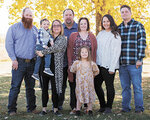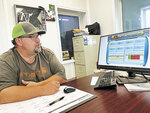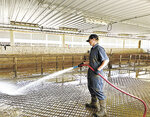Kevin Souza
Victory Farms
Revillo, South Dakota
5,000 cows
Describe your facilities. We have a cross-ventilated freestall barn that we bed with manure solids. We milk in two double-35 parallel milking parlors. There are currently two manure digesters under construction on our farm, and we’ve been told they could start producing purified natural gas as soon as November. We have an in-house employee who makes all of our mating choices.
What is your current pregnancy rate? Our pregnancy rate is 34%.
What is your reproduction program? We use SCR activity monitors to determine when our animals are in heat. If a cow isn’t pregnant by 82 days in milk, we will give her a CIDR insert.
Describe your breeding philosophy. Our chief goal is to produce healthy, productive cows. We choose our sires based on the Dairy Wellness Profit Index along with a combination of high fat and protein production traits.
What guidelines do you follow to reach the goals for your breeding program? We have made use of in vitro fertilization to accelerate the genetic advancement of our herd. We harvest 60-80 embryos per week from our top animals. This usually involves about 15 head each week. We get the majority of our embryos from our heifers.
What are the top traits you look for in breeding your dairy herd, and how has this changed since you started farming? We look for high daughter pregnancy rate, high percentages of fat and protein, high pounds of fat and protein, low somatic cell count, superior wellness traits and sound udders. What has changed is the amount of genetic information that’s now available. Polled genetics have been getting a lot more attention lately. We also look at the genetics for mastitis resistance and susceptibility to scours.
What are certain traits you try to avoid? We try to avoid sires with a low DPR. If we find a sire that we really like but has a low DPR, we will mate him to cows that have a high DPR. We also avoid any sires that carry the Jersey neuropathy with splayed forelimbs trait.
Describe the ideal cow for your herd. She is medium-sized and healthy, and produces a lot of pounds of fat and protein that gets bred back right away.
What role do genetics have in reaching the goals of your farm? We are using the highest genomic bulls for our IVF program. We do genomic testing on all of our animals and breed our top females to top bulls.
What percentage of your herd is bred to sexed, conventional and beef semen? About 50% of our milk herd is bred with non-sexed beef semen, and 35% of our milk herd receives embryos. The top 15% of our milk herd is bred with sexed Jersey semen. All of our heifers are serviced for the first two heats with sexed Jersey semen.
What is your conception rate? How does this differ with different types of semen? The conception rate with beef sires is 50% and is 45% with sexed Jersey semen. The conception rate with embryos is 43%. We had been using SimAngus beef sires but are switching to Charolais bulls next month. We use the TD Beef program from Select Sires to help us choose beef bulls.
What is the greatest lesson you have learned through your breeding program? You have to spend money on semen to get better genetics. In other words, you get what you pay for. We use all of the information that’s available to individually mate each of our animals.
What is the age of your heifers at first service? We breed our heifers at 11 months of age.
How does your heifer inventory affect your breeding program? Select Sires runs a quarterly report that details our dairy herd’s cull numbers and death loss. This report helps us calculate how many replacements we will need to produce. After we started with this program, we were able to reduce our heifer inventory by 1,000 head. This has enabled us to be more selective regarding which animals will be bred to Jersey sires and which will be bred to beef bulls.
Tell us about your farm. This farm is owned by three families, and we are the managing partners. My family and I moved here from California 24 years ago. I loved growing up in California but am glad we moved here. My wife, Suzanne, and I think that this is a great place to raise kids. Our daughter, Hayley, and her husband, Ryan Anderson, both work on our farm and live just a couple of miles away. Our daughter, Audrey, is a veterinarian and lives in Miller, South Dakota, with her husband, Brandon Peschong.



Comments
No comments on this item Please log in to comment by clicking here